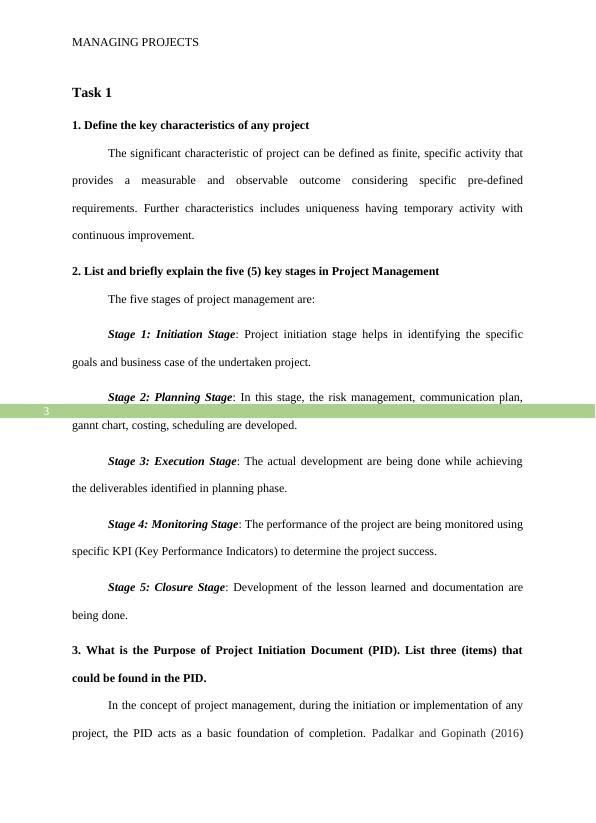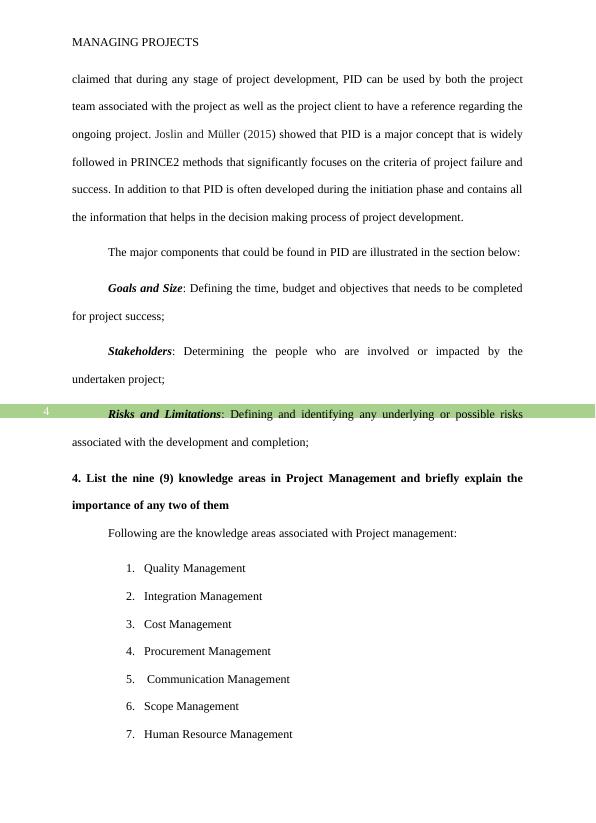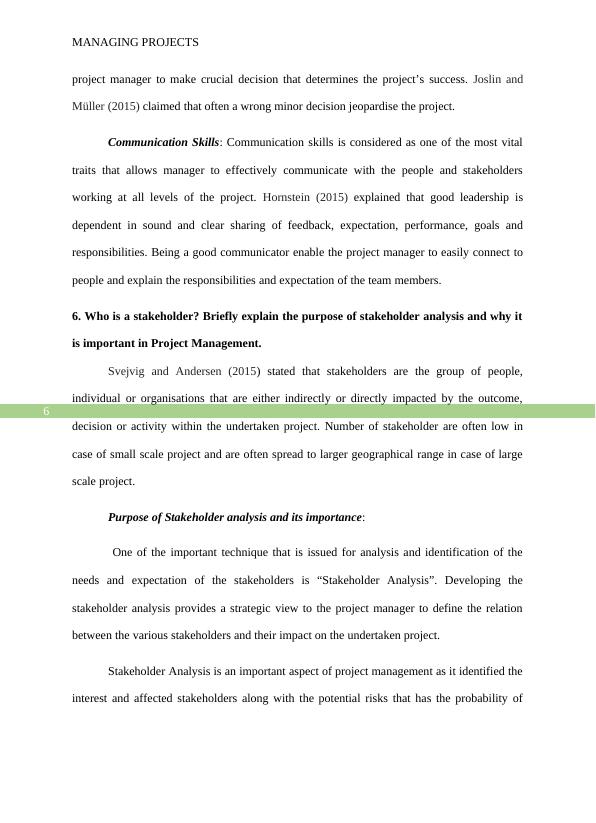Managing Projects: Assessment Questions, Case Study, and Stakeholder Analysis
The assignment aims to assess the benefits and limitations of different approaches to project planning and control, and demonstrate competence in managing resources.
31 Pages5244 Words42 Views
Added on 2023-01-18
About This Document
This document provides assessment questions, a case study, and a stakeholder analysis for managing projects. It covers key characteristics of projects, stages in project management, the purpose of a project initiation document, knowledge areas in project management, attributes of a project manager, and more.
Managing Projects: Assessment Questions, Case Study, and Stakeholder Analysis
The assignment aims to assess the benefits and limitations of different approaches to project planning and control, and demonstrate competence in managing resources.
Added on 2023-01-18
ShareRelated Documents
Running head: MANAGING PROJECTS
SIM 335 Managing Projects Assessment Question
[Student Name]
[Student ID]
SIM 335 Managing Projects Assessment Question
[Student Name]
[Student ID]

1
MANAGING PROJECTS
Table of Contents
Task 1.........................................................................................................................................3
1. Define the key characteristics of any project.....................................................................3
2. List and briefly explain the five (5) key stages in Project Management............................3
3. What is the Purpose of Project Initiation Document (PID). List three (items) that could
be found in the PID................................................................................................................3
4. List the nine (9) knowledge areas in Project Management and briefly explain the
importance of any two of them..............................................................................................4
5. List five attributes or characteristics of a project Manager and briefly discuss or explain
the importance of any two of them........................................................................................5
6. Who is a stakeholder? Briefly explain the purpose of stakeholder analysis and why it is
important in Project Management..........................................................................................6
7. Draw the corresponding network diagram and show the critical path...............................6
Task 2: Case Study.....................................................................................................................8
Introduction............................................................................................................................8
1: Project Charter...................................................................................................................8
A. Scope of the Project.......................................................................................................8
C. Aims of the Project........................................................................................................9
D. Objective of the Project.................................................................................................9
E. Assumption....................................................................................................................9
F. Major Constraints.........................................................................................................10
G. Project Milestones.......................................................................................................10
2: Stakeholders.....................................................................................................................11
A. Identification...............................................................................................................11
B. Stakeholder Analysis...................................................................................................11
C. Stakeholder Impact Matrix..........................................................................................12
3: Project Management Plan................................................................................................13
MANAGING PROJECTS
Table of Contents
Task 1.........................................................................................................................................3
1. Define the key characteristics of any project.....................................................................3
2. List and briefly explain the five (5) key stages in Project Management............................3
3. What is the Purpose of Project Initiation Document (PID). List three (items) that could
be found in the PID................................................................................................................3
4. List the nine (9) knowledge areas in Project Management and briefly explain the
importance of any two of them..............................................................................................4
5. List five attributes or characteristics of a project Manager and briefly discuss or explain
the importance of any two of them........................................................................................5
6. Who is a stakeholder? Briefly explain the purpose of stakeholder analysis and why it is
important in Project Management..........................................................................................6
7. Draw the corresponding network diagram and show the critical path...............................6
Task 2: Case Study.....................................................................................................................8
Introduction............................................................................................................................8
1: Project Charter...................................................................................................................8
A. Scope of the Project.......................................................................................................8
C. Aims of the Project........................................................................................................9
D. Objective of the Project.................................................................................................9
E. Assumption....................................................................................................................9
F. Major Constraints.........................................................................................................10
G. Project Milestones.......................................................................................................10
2: Stakeholders.....................................................................................................................11
A. Identification...............................................................................................................11
B. Stakeholder Analysis...................................................................................................11
C. Stakeholder Impact Matrix..........................................................................................12
3: Project Management Plan................................................................................................13

2
MANAGING PROJECTS
A. Gantt Chart..................................................................................................................13
B. Work Breakdown Structure.........................................................................................14
4: Project Life Cycle................................................................................................................14
A. Project Life Cycle Model............................................................................................14
5: Communication Plan........................................................................................................15
A. Communication plans for the Project..........................................................................15
6. Cost Allocation.................................................................................................................17
7: Risks and Mitigation........................................................................................................18
A. Identification of Project Risks.....................................................................................18
B. Risk Log......................................................................................................................20
Conclusion............................................................................................................................22
Bibliography.............................................................................................................................23
MANAGING PROJECTS
A. Gantt Chart..................................................................................................................13
B. Work Breakdown Structure.........................................................................................14
4: Project Life Cycle................................................................................................................14
A. Project Life Cycle Model............................................................................................14
5: Communication Plan........................................................................................................15
A. Communication plans for the Project..........................................................................15
6. Cost Allocation.................................................................................................................17
7: Risks and Mitigation........................................................................................................18
A. Identification of Project Risks.....................................................................................18
B. Risk Log......................................................................................................................20
Conclusion............................................................................................................................22
Bibliography.............................................................................................................................23

3
MANAGING PROJECTS
Task 1
1. Define the key characteristics of any project
The significant characteristic of project can be defined as finite, specific activity that
provides a measurable and observable outcome considering specific pre-defined
requirements. Further characteristics includes uniqueness having temporary activity with
continuous improvement.
2. List and briefly explain the five (5) key stages in Project Management
The five stages of project management are:
Stage 1: Initiation Stage: Project initiation stage helps in identifying the specific
goals and business case of the undertaken project.
Stage 2: Planning Stage: In this stage, the risk management, communication plan,
gannt chart, costing, scheduling are developed.
Stage 3: Execution Stage: The actual development are being done while achieving
the deliverables identified in planning phase.
Stage 4: Monitoring Stage: The performance of the project are being monitored using
specific KPI (Key Performance Indicators) to determine the project success.
Stage 5: Closure Stage: Development of the lesson learned and documentation are
being done.
3. What is the Purpose of Project Initiation Document (PID). List three (items) that
could be found in the PID.
In the concept of project management, during the initiation or implementation of any
project, the PID acts as a basic foundation of completion. Padalkar and Gopinath (2016)
MANAGING PROJECTS
Task 1
1. Define the key characteristics of any project
The significant characteristic of project can be defined as finite, specific activity that
provides a measurable and observable outcome considering specific pre-defined
requirements. Further characteristics includes uniqueness having temporary activity with
continuous improvement.
2. List and briefly explain the five (5) key stages in Project Management
The five stages of project management are:
Stage 1: Initiation Stage: Project initiation stage helps in identifying the specific
goals and business case of the undertaken project.
Stage 2: Planning Stage: In this stage, the risk management, communication plan,
gannt chart, costing, scheduling are developed.
Stage 3: Execution Stage: The actual development are being done while achieving
the deliverables identified in planning phase.
Stage 4: Monitoring Stage: The performance of the project are being monitored using
specific KPI (Key Performance Indicators) to determine the project success.
Stage 5: Closure Stage: Development of the lesson learned and documentation are
being done.
3. What is the Purpose of Project Initiation Document (PID). List three (items) that
could be found in the PID.
In the concept of project management, during the initiation or implementation of any
project, the PID acts as a basic foundation of completion. Padalkar and Gopinath (2016)

4
MANAGING PROJECTS
claimed that during any stage of project development, PID can be used by both the project
team associated with the project as well as the project client to have a reference regarding the
ongoing project. Joslin and Müller (2015) showed that PID is a major concept that is widely
followed in PRINCE2 methods that significantly focuses on the criteria of project failure and
success. In addition to that PID is often developed during the initiation phase and contains all
the information that helps in the decision making process of project development.
The major components that could be found in PID are illustrated in the section below:
Goals and Size: Defining the time, budget and objectives that needs to be completed
for project success;
Stakeholders: Determining the people who are involved or impacted by the
undertaken project;
Risks and Limitations: Defining and identifying any underlying or possible risks
associated with the development and completion;
4. List the nine (9) knowledge areas in Project Management and briefly explain the
importance of any two of them
Following are the knowledge areas associated with Project management:
1. Quality Management
2. Integration Management
3. Cost Management
4. Procurement Management
5. Communication Management
6. Scope Management
7. Human Resource Management
MANAGING PROJECTS
claimed that during any stage of project development, PID can be used by both the project
team associated with the project as well as the project client to have a reference regarding the
ongoing project. Joslin and Müller (2015) showed that PID is a major concept that is widely
followed in PRINCE2 methods that significantly focuses on the criteria of project failure and
success. In addition to that PID is often developed during the initiation phase and contains all
the information that helps in the decision making process of project development.
The major components that could be found in PID are illustrated in the section below:
Goals and Size: Defining the time, budget and objectives that needs to be completed
for project success;
Stakeholders: Determining the people who are involved or impacted by the
undertaken project;
Risks and Limitations: Defining and identifying any underlying or possible risks
associated with the development and completion;
4. List the nine (9) knowledge areas in Project Management and briefly explain the
importance of any two of them
Following are the knowledge areas associated with Project management:
1. Quality Management
2. Integration Management
3. Cost Management
4. Procurement Management
5. Communication Management
6. Scope Management
7. Human Resource Management

5
MANAGING PROJECTS
8. Risk Management
9. Time Management
Importance of Time and Risk management are described in the below section.
Importance of Time Management: Kerzner and Kerzner (2017) claimed that time is
one of the essential factors that determines a project’s success. While working on a tight
schedule, every deadlines needs to be met as planned. Further, issues or lack of proper
management of schedule could results in project failure and negative impact on the
organisation considering the long run. A good time management deals with working more
effectively within the allocated time. Time management enables proper scheduling, tracking,
setting priorities, and monitoring of the project progress.
Importance of Risk Management: According to Fleming, and Koppelman (2016),
every project is always associated with some kind of risks. Risks within a project are descried
as unwanted situations or event that negatively impacts the projects success. Application of
proper risks management process allows the project manager to analyse, identify the possible
risks. This allows in developing proper mitigation plan thus reducing the impact of risks and
increasing the changes of project success.
5. List five attributes or characteristics of a project Manager and briefly discuss or
explain the importance of any two of them
Five major qualities or attributes of project manager includes decision making skills,
leadership skills, communication skills, technical expertise and good negotiation skills.
Importance of two skills are demonstrated in the section below:
Decision Making Skills: There are often unforeseen risks or events that are associated
with the development phase of the project. Being a good ad quick decision maker enable the
MANAGING PROJECTS
8. Risk Management
9. Time Management
Importance of Time and Risk management are described in the below section.
Importance of Time Management: Kerzner and Kerzner (2017) claimed that time is
one of the essential factors that determines a project’s success. While working on a tight
schedule, every deadlines needs to be met as planned. Further, issues or lack of proper
management of schedule could results in project failure and negative impact on the
organisation considering the long run. A good time management deals with working more
effectively within the allocated time. Time management enables proper scheduling, tracking,
setting priorities, and monitoring of the project progress.
Importance of Risk Management: According to Fleming, and Koppelman (2016),
every project is always associated with some kind of risks. Risks within a project are descried
as unwanted situations or event that negatively impacts the projects success. Application of
proper risks management process allows the project manager to analyse, identify the possible
risks. This allows in developing proper mitigation plan thus reducing the impact of risks and
increasing the changes of project success.
5. List five attributes or characteristics of a project Manager and briefly discuss or
explain the importance of any two of them
Five major qualities or attributes of project manager includes decision making skills,
leadership skills, communication skills, technical expertise and good negotiation skills.
Importance of two skills are demonstrated in the section below:
Decision Making Skills: There are often unforeseen risks or events that are associated
with the development phase of the project. Being a good ad quick decision maker enable the

6
MANAGING PROJECTS
project manager to make crucial decision that determines the project’s success. Joslin and
Müller (2015) claimed that often a wrong minor decision jeopardise the project.
Communication Skills: Communication skills is considered as one of the most vital
traits that allows manager to effectively communicate with the people and stakeholders
working at all levels of the project. Hornstein (2015) explained that good leadership is
dependent in sound and clear sharing of feedback, expectation, performance, goals and
responsibilities. Being a good communicator enable the project manager to easily connect to
people and explain the responsibilities and expectation of the team members.
6. Who is a stakeholder? Briefly explain the purpose of stakeholder analysis and why it
is important in Project Management.
Svejvig and Andersen (2015) stated that stakeholders are the group of people,
individual or organisations that are either indirectly or directly impacted by the outcome,
decision or activity within the undertaken project. Number of stakeholder are often low in
case of small scale project and are often spread to larger geographical range in case of large
scale project.
Purpose of Stakeholder analysis and its importance:
One of the important technique that is issued for analysis and identification of the
needs and expectation of the stakeholders is “Stakeholder Analysis”. Developing the
stakeholder analysis provides a strategic view to the project manager to define the relation
between the various stakeholders and their impact on the undertaken project.
Stakeholder Analysis is an important aspect of project management as it identified the
interest and affected stakeholders along with the potential risks that has the probability of
MANAGING PROJECTS
project manager to make crucial decision that determines the project’s success. Joslin and
Müller (2015) claimed that often a wrong minor decision jeopardise the project.
Communication Skills: Communication skills is considered as one of the most vital
traits that allows manager to effectively communicate with the people and stakeholders
working at all levels of the project. Hornstein (2015) explained that good leadership is
dependent in sound and clear sharing of feedback, expectation, performance, goals and
responsibilities. Being a good communicator enable the project manager to easily connect to
people and explain the responsibilities and expectation of the team members.
6. Who is a stakeholder? Briefly explain the purpose of stakeholder analysis and why it
is important in Project Management.
Svejvig and Andersen (2015) stated that stakeholders are the group of people,
individual or organisations that are either indirectly or directly impacted by the outcome,
decision or activity within the undertaken project. Number of stakeholder are often low in
case of small scale project and are often spread to larger geographical range in case of large
scale project.
Purpose of Stakeholder analysis and its importance:
One of the important technique that is issued for analysis and identification of the
needs and expectation of the stakeholders is “Stakeholder Analysis”. Developing the
stakeholder analysis provides a strategic view to the project manager to define the relation
between the various stakeholders and their impact on the undertaken project.
Stakeholder Analysis is an important aspect of project management as it identified the
interest and affected stakeholders along with the potential risks that has the probability of

7
MANAGING PROJECTS
disrupting project success. In addition to that, it identified the stakeholders with whom the
information needs to be shared at different stage.
MANAGING PROJECTS
disrupting project success. In addition to that, it identified the stakeholders with whom the
information needs to be shared at different stage.

End of preview
Want to access all the pages? Upload your documents or become a member.
Related Documents
Managing Projects INTRODUCTION 1 TASK 11lg...
|22
|5746
|77
Managing Projects Assignment (Doc)lg...
|18
|4261
|430
Role of Work Breakdown Structure - Doclg...
|17
|4389
|17
Managing Projects: Key Characteristics, Project Initiation, Feasibility, Knowledge Areas, Project Manager, Network Diagram, Project Management Reportlg...
|17
|4309
|22
Project Initiation Document PDFlg...
|14
|4880
|154
Project Management Plan for Hybrid System Implementationlg...
|20
|4113
|88
